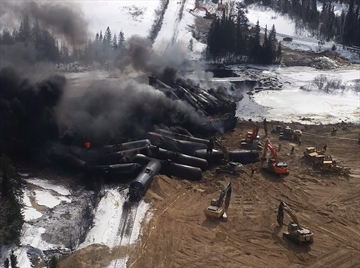Repost from Insurance Journal (Reuters)
Canada Transport Watchdog to Introduce New Tank Cars Ahead of Schedule
By David Ljunggren | March 18, 2015
Canada’s transportation watchdog said that recent fiery derailments of trains hauling crude oil mean a new generation of stronger tanker wagons should be introduced ahead of schedule.
The Transportation Safety Board (TSB) is probing two accidents within the last month involving Canadian National Railway Co. oil trains which came off the tracks and caught fire near the small northern Ontario town of Gogama.
Both trains were hauling CPC-1232 crude tankers, meant to be safer than the older DOT-111 models that blew up in downtown Lac-Megantic, Quebec in 2013, killing 47 people. Canada last week unveiled tough standards for a new generation of tanker cars that would replace the CPC-1232s by 2025 at the latest.
“While the proposed standards look promising, the TSB has concerns about the implementation timeline, given initial observations of the performance of CPC-1232 cars in recent derailments,” the agency said in a release.
“If older tank cars, including the CPC-1232 cars, are not phased out sooner, then the regulator and industry need to take more steps to reduce the risk of derailments or consequences following a derailment carrying flammable liquids,” it said, but gave no details.
The agency said track failures may have played a role in each of the Gogama derailments as well as in the case of an oil train that left the tracks near Minnipuka, also in northern Ontario. No crude caught fire in that accident.
The TSB has issued a safety advisory letter asking the federal transport ministry to review the risk assessments conducted for the area.
“Petroleum crude oil unit trains transporting heavily-loaded tank cars will tend to impart higher than usual forces to the track infrastructure during their operation,” said the agency.
“These higher forces expose any weaknesses that may be present in the track structure, making the track more susceptible to failure.”
It noted trains traveling in the area were under orders to travel slowly to protect against various infrastructure and track maintenance issues.
CN spokesman Jim Feeny said the company “has enhanced its already rigorous infrastructure and mechanical inspection procedures on this northern Ontario rail corridor.”
The office of Transport Minister Lisa Raitt – which has overall responsibility for regulating the rail industry – was not immediately available for comment.
(Additional reporting by Allison Martell in Toronto; editing by Chizu Nomiyama and Marguerita Choy)Related article:
Canada Proposes Tough New Oil Tank Car Standards




You must be logged in to post a comment.